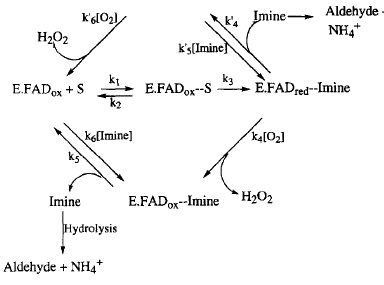User:Martha Blakely/Sandbox 1
From Proteopedia
(→Catalytic Pathway) |
|||
| Line 17: | Line 17: | ||
[[Image:MAOcatalytic.jpg]] | [[Image:MAOcatalytic.jpg]] | ||
| - | The oxidative deamination of amine neurotransmitters is catalyzed by both monoamine oxidases. The image above shows the two generally proposed and accepted catalytic pathways for this oxidation; the lower loop is the case for most substrates. In this loop, the enzyme-imine compound (E.FAD<sub>red</sub>--Imine) reacts with oxygen (O<sub>2</sub>) to create H<sub>2</sub>O<sub>2</sub> and the oxidized enzyme-imine compound (E.FAD<sub>ox</sub>). The imine is then reduced to the ammonium ion (NH<sub>4</sub><sup>+</sup>) and its respective aldehyde. The cycle goes around the loop another time when an amine (S) binds to the active site within the enzyme (E.FAD<sub>ox</sub> + S). | + | The oxidative deamination of amine neurotransmitters is catalyzed by both monoamine oxidases. The image above shows the two generally proposed and accepted catalytic pathways for this oxidation; the lower loop is the case for most substrates. In this loop, the enzyme-imine compound (E.FAD<sub>red</sub>--Imine) reacts with oxygen (O<sub>2</sub>) to create H<sub>2</sub>O<sub>2</sub> and the oxidized enzyme-imine compound (E.FAD<sub>ox</sub>). The imine is then reduced to the ammonium ion (NH<sub>4</sub><sup>+</sup>) and its respective aldehyde. The cycle goes around the loop another time when an amine (S) binds to the active site within the enzyme (E.FAD<sub>ox</sub> + S). |
| + | |||
| + | Hydrogen peroxide is shown as a product in this catalytic pathway. Due to hydrogen peroxide's association with health problems such as Parkinson's disease and Alzheimer's disease, MAO inhibitors have recently been created with possible neuroprotective functions. | ||
==Inhibition== | ==Inhibition== | ||
Revision as of 03:45, 25 June 2010
|
(MAO-B) is a mitochondrial outer-membrane flavoenzyme. It is one of two isozymes (MOA-A is the other), which catalyzes the oxidative deamination of amine neurotransmitters, including serotonin, dopamine, and epinephrine. The flavin-dependent enzymes use O2 as an electron acceptor in the catalytic pathway which includes hydrogen peroxide, H2O2, as a product. Increased H2O2 levels promote apoptotic signaling of cells. Thus, researchers have found that increased levels of MAO-B, whose levels in the brain increase at least 3-fold on aging, are related to decreased levels of neuronal cells. The cells in the brain particularly targeted are dopamine-producing cells, which results in the development of Parkinson’s Disease. A popular example related to the development of Parkinson symptoms based on MAO-B levels is the oxidation of 1-methyl-4-phenyl-1,2,3,6-tetrahydropyridine (MPTP) to 1-methyl-4-phenylpyridinium (MPP+) which destroys glial cells. The inhibition of MAO-B prevents against this cell death behavior.
Inhibitors of MAO-B such as deprenyl and rasagiline have been developed in order to protect the brain from neurological disorders. Deprenyl is used in L-dopa therapy which acts as treatment and protection for Parkinson's and pre-Parkinson's patients.
Contents |
Structure
Structurally, MAO-B is a dimer with each monomer composed of 520 amino acids. The sequence form a helix on each monomer that is responsible for the attachment to the outer-membrane of mitochondria. This α-helix resides in the lipid bilayer. In addition to the C-terminal helices, other hydrophobic side chains such as Pro 109 and Ile 110 also contribute to attachment.
The active site of MAO-B is a flat hydrophobic cavity that is separated into two parts, the entrance cavity and the substrate cavity. The dual nature of the active site allows for binding of differently sized substrates. Some are large enough to fill both cavities, some only fill the substrate cavity, and other substrates are even smaller. The wide range of substrate size can partially be contributed to a boundary between the two cavities. Four residues () form this boundary. Ile 199 is a gating residue that can be in the “open” or “closed” positions. Entrance into the connected cavities is determined by the movement of a loop of amino acids () located at the protein surface near the membrane attachment. This loop prevents solvent from entering the active site. Its location relative to the mitochondrial outer-membrane implies that passage into the active site must be done near the membrane.
Each molecule has its own covalently bonded to each chain.
Catalytic Pathway
The oxidative deamination of amine neurotransmitters is catalyzed by both monoamine oxidases. The image above shows the two generally proposed and accepted catalytic pathways for this oxidation; the lower loop is the case for most substrates. In this loop, the enzyme-imine compound (E.FADred--Imine) reacts with oxygen (O2) to create H2O2 and the oxidized enzyme-imine compound (E.FADox). The imine is then reduced to the ammonium ion (NH4+) and its respective aldehyde. The cycle goes around the loop another time when an amine (S) binds to the active site within the enzyme (E.FADox + S).
Hydrogen peroxide is shown as a product in this catalytic pathway. Due to hydrogen peroxide's association with health problems such as Parkinson's disease and Alzheimer's disease, MAO inhibitors have recently been created with possible neuroprotective functions.
Inhibition
References, for further information on Monoamine oxidase B
- Binda, Newton-Vinson, Hubalek, Edmondson, and Mattevi (2002) "Structure of human monoamine oxidase B, a drug target for the treatment of neurological disorders", Nature Structural Biology 9: 22-26.
- Edmondson, Binda, Wang, Upadhyay, Mattevi (2009) "Molecular and Mechanistic Poperties of the Membrane-Bound Mitochondrial Monoamine Oxidases", Biochemistry 48: 4220-4230.
- Youdim, Edmondson, Tipton (2006) "The therapeutic potential of monoamine oxidase inhibitors", Nature Reviews 7:295-309.

